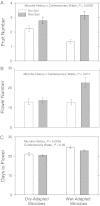Rapid responses of soil microorganisms improve plant fitness in novel environments
- PMID: 22891306
- PMCID: PMC3435152
- DOI: 10.1073/pnas.1202319109
Rapid responses of soil microorganisms improve plant fitness in novel environments
Erratum in
-
Correction for Lau et al., Rapid responses of soil microorganisms improve plant fitness in novel environments.Proc Natl Acad Sci U S A. 2021 Nov 30;118(48):e2118690118. doi: 10.1073/pnas.2118690118. Proc Natl Acad Sci U S A. 2021. PMID: 34819383 Free PMC article. No abstract available.
Abstract
Global change is challenging plant and animal populations with novel environmental conditions, including increased atmospheric CO(2) concentrations, warmer temperatures, and altered precipitation regimes. In some cases, contemporary or "rapid" evolution can ameliorate the effects of global change. However, the direction and magnitude of evolutionary responses may be contingent upon interactions with other community members that also are experiencing novel environmental conditions. Here, we examine plant adaptation to drought stress in a multigeneration experiment that manipulated aboveground-belowground feedbacks between plants and soil microbial communities. Although drought stress reduced plant growth and accelerated plant phenologies, surprisingly, plant evolutionary responses to drought were relatively weak. In contrast, plant fitness in both drought and nondrought environments was linked strongly to the rapid responses of soil microbial community structure to moisture manipulations. Specifically, plants were most fit when their contemporary environmental conditions (wet vs. dry soil) matched the historical environmental conditions (wet vs. dry soil) of their associated microbial community. Together, our findings suggest that, when faced with environmental change, plants may not be limited to "adapt or migrate" strategies; instead, they also may benefit from association with interacting species, especially diverse soil microbial communities, that respond rapidly to environmental change.
Conflict of interest statement
The authors declare no conflict of interest.
Figures



References
-
- Pimm SL. Climate disruption and biodiversity. Curr Biol. 2009;19:R595–R601. - PubMed
-
- Sala OE, et al. Global biodiversity scenarios for the year 2100. Science. 2000;287:1770–1774. - PubMed
-
- Parmesan C. Ecological and evolutionary responses to recent climate change. Annu Rev Ecol Evol Syst. 2006;37:637–669.
-
- Parmesan C, Yohe G. A globally coherent fingerprint of climate change impacts across natural systems. Nature. 2003;421:37–42. - PubMed
Publication types
MeSH terms
LinkOut - more resources
Full Text Sources
Other Literature Sources

